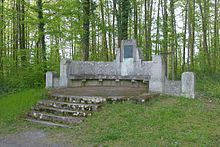Exedra
The exedra (plural exedra ) is a niche-like space that opens onto a courtyard , square or hall . It can be designed freely or with a column position .
Ancient architecture
In ancient Greece , the ἐξέδρα exhédra , also the εξέδριον exhédrion , was a specially designed, raised niche or the open or roofed platform as an extension of a large public meeting room, for example the peristyle or in the gymnasium . With seats, it served as a “social room ” in the sense of a private room for private conversation, or for reading aloud and discussing in small groups.
It found its way into the Roman villa ( exedrium ) and was an interior design element there as an adjoining room (conversation room, consulting room) or in the bathroom. Vitruvius compares it to the rotunda .
In Hellenism it developed parallel to the aedicula , the booth niche for sacred and secular statues and statuettes .
Christian church building
In early Christian times, the shape of the exedra was also adopted for a raised altar niche in a church building and can also be found in early Christian basilicas . There it is usually on the narrow side opposite the exit to the forum . It corresponds to the term apse 'chancel'. Augustine already mentions it as gradus exedrae in the sense of presbytery / choir . It also serves as the seat of the bishop ( Cathedra ) and other priests ( Synthronon ) .
From the Exedra developed over the main apse and the Mehrfachapsiden (main apse) in the Romanesque and Byzantine art , the Chapel in the Gothic style , as chapels of the ambulatory (behind the presbytery / choir, which take the name apse '), as well as the side chapels of the side altars in the long - and transept .
Secular building from the Renaissance

The exedra also found its way into the formal language of the Renaissance , now also detached from the structure. In garden art , the ancient form was taken up again as a kind of platform on a garden wall, which offers a view of the city or the valley (for example in the Villa d'Este , 16th century). The shell-shaped conche of the Baroque and Rococo was formed via Mannerism .
archeology
In Italian and Maltese archeology , a semicircular-oval, usually paved forecourt or the facade of a prehistoric cult building located on such a forecourt is called Exedra (Italian Esedra ). In particular, the places in front of Maltese temples or Sardinian giant tombs are known as exedra.
Architecture examples
Exedra of the Roman villa , La Olmeda (near Gañinas, Saldaña) in Palencia Spain
Exedra of the Baths of Trajan in Rome
See also
Individual evidence
- ^ A b Karl Ernst Georges : exedra . In: Comprehensive Latin-German concise dictionary . 8th edition. Hahnsche Buchhandlung, Hanover, Sp. 2538 f . ( zeno.org - 1913/1918; Reprint: Wissenschaftliche Buchgesellschaft, Darmstadt 1998).
- ↑ Georges: exedrium . In: Latin-German concise dictionary . Sp. 2539 ( zeno.org ).
- ↑ a b Otto Lueger : Exedra . In: Lexicon of all technology and its auxiliary sciences . tape 3 . Stuttgart / Leipzig 1906, p. 521 ( zeno.org ).
- ↑ Exĕdra . In: Meyers Großes Konversations-Lexikon . tape 6 . Leipzig 1906, p. 209 ( zeno.org ).
- ↑ Cic. ep. 7, 23, 3; after entry exedrium. In: Georges: Latin-German concise dictionary . Sp. 2539 .
- ↑ Cic. de or. 3, 17; de nat. deor. 1.15; de fin. 5, 4; after entry exedra. In: Georges: Latin-German concise dictionary . Sp. 2539 .
- ↑ cf. the adjoining room of the atrium: Fig. Architecture V. Roman architecture. 4. House of the Panza at Pompeii. In: Meyers Großes Konversations-Lexikon . tape 1 , 1906, timetable for the history of architecture ( zeno.org ).
- ↑ Vitr. 5, 11, 2; after entry exedra. In: Georges: Latin-German concise dictionary . Sp. 2539 .
- ↑ Augustine. de civ. dei 22, 8, 23. p. 581, 1 D2; after entry exedra. In: Georges: Latin-German concise dictionary . Sp. 2539 .
- ↑ Exĕdra . In: Heinrich August Pierer , Julius Löbe (Hrsg.): Universal Lexicon of the Present and the Past . 4th edition. tape 6 . Altenburg 1858, p. 34 ( zeno.org ).
- ↑ Paolo Gambassini, Alberto Moravetti et al .: Guide archeologiche preistoria e protostoria in Italia , XIII Congresso Internazionale delle Sienze Preistoriche e Protostoriche, ABACO, 1995, p. 77.




